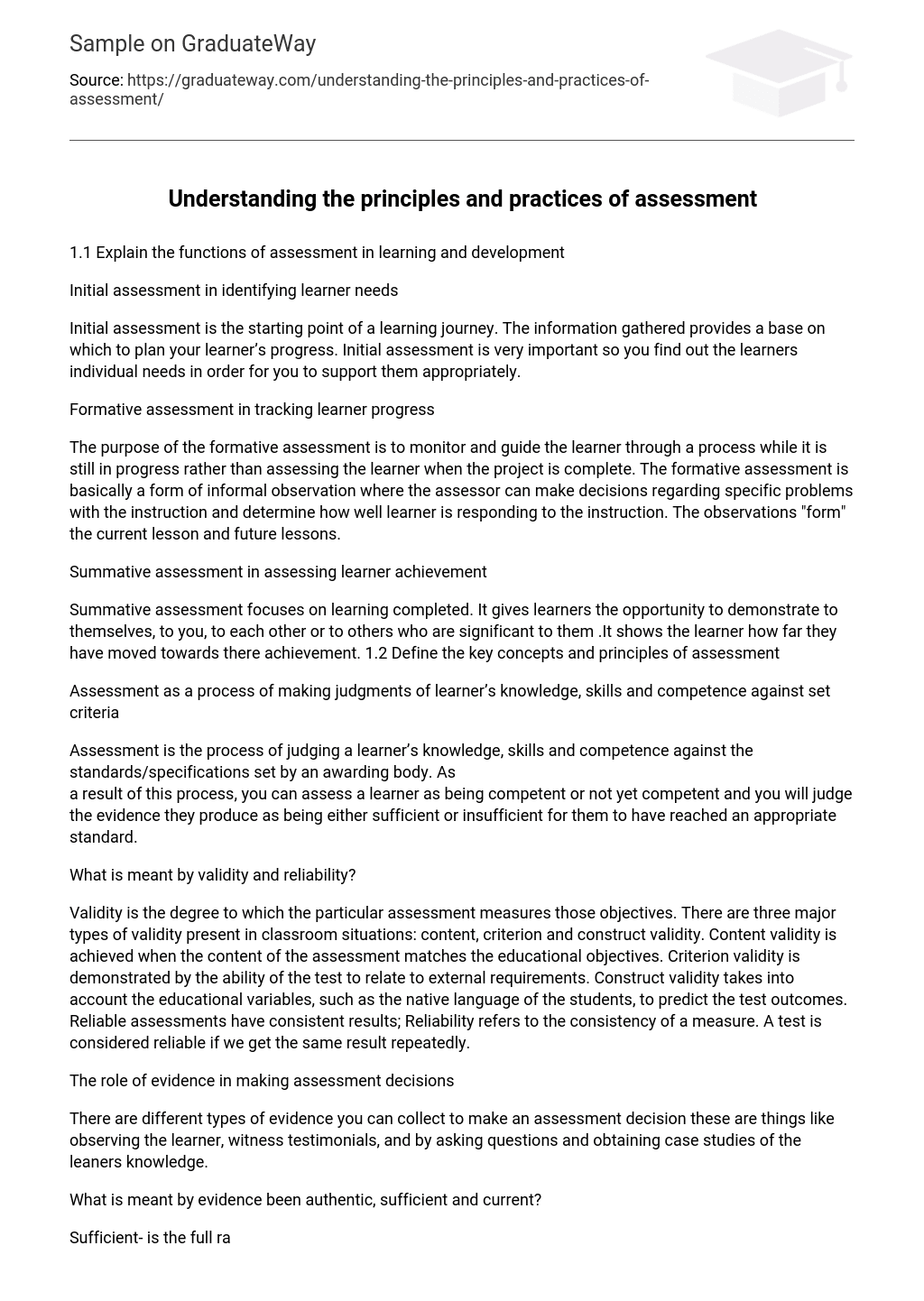1.1 Explain the functions of assessment in learning and development
Initial assessment in identifying learner needs
Initial assessment is the starting point of a learning journey. The information gathered provides a base on which to plan your learner’s progress. Initial assessment is very important so you find out the learners individual needs in order for you to support them appropriately.
Formative assessment in tracking learner progress
The purpose of the formative assessment is to monitor and guide the learner through a process while it is still in progress rather than assessing the learner when the project is complete. The formative assessment is basically a form of informal observation where the assessor can make decisions regarding specific problems with the instruction and determine how well learner is responding to the instruction. The observations “form” the current lesson and future lessons.
Summative assessment in assessing learner achievement
Summative assessment focuses on learning completed. It gives learners the opportunity to demonstrate to themselves, to you, to each other or to others who are significant to them .It shows the learner how far they have moved towards there achievement. 1.2 Define the key concepts and principles of assessment
Assessment as a process of making judgments of learner’s knowledge, skills and competence against set criteria
Assessment is the process of judging a learner’s knowledge, skills and competence against the standards/specifications set by an awarding body. As
a result of this process, you can assess a learner as being competent or not yet competent and you will judge the evidence they produce as being either sufficient or insufficient for them to have reached an appropriate standard.
What is meant by validity and reliability?
Validity is the degree to which the particular assessment measures those objectives. There are three major types of validity present in classroom situations: content, criterion and construct validity. Content validity is achieved when the content of the assessment matches the educational objectives. Criterion validity is demonstrated by the ability of the test to relate to external requirements. Construct validity takes into account the educational variables, such as the native language of the students, to predict the test outcomes. Reliable assessments have consistent results; Reliability refers to the consistency of a measure. A test is considered reliable if we get the same result repeatedly.
The role of evidence in making assessment decisions
There are different types of evidence you can collect to make an assessment decision these are things like observing the learner, witness testimonials, and by asking questions and obtaining case studies of the leaners knowledge.
What is meant by evidence been authentic, sufficient and current?
Sufficient- is the full range of performance identified in the standards covered does the evidence shows competence over a period of time and in a range of contexts. Current – does the evidence show that the candidate can perform the competence while working? Authentic-is this the learners own work?
The importance of objectivity and fairness to learner
Fairness ensures that everyone has an equal chance of getting a good assessment. It is important that you act fairly for all students if you
expect to be respected. It is important to be as objective as possible to be objective is to base your judgment on some shared principle/rule/law/value, leaving aside your own emotional reaction to the situation which might not be shared by the learners.
The importance of transparency for the learner
Transparency means that you and your doings are visible to learners and teachers within a learning environment and to make participants available to each other as resources for their learning activities. This will improve quality and a more engaging learning experience. 1.3 Explain the responsibilities of the assessor
Understanding and applying the standards and requirements they are working to Trainer’s knowledge and skills in each standard area will impact their ability to teach learners in chosen area. Standards spell out what learners are expected to learn. Without standards, we don’t have goals to aim for. By matching what is taught in the classroom to the standards in each subject area, students we will know what teachers should be teaching, what learners should be learning and what they will be tested on. Planning assessments to meet learner needs
Assessment is a process that helps learners to identify their current skills and knowledge, to plan their future learning and to know how well they are doing in achieving their own learning needs and goals. It identifies, describes and demonstrates evidence of a person’s current skills and knowledge. It can also be used to recognize and record learner’s achievements and to assist in identifying how teaching and learning processes can be improved.





